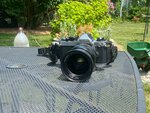

Everyone in life has something that they are passionate about. Suffolk Community College professor John Stefanik’s passion is photography, primarily through pictures taken with black-and-white film and photogenic drawings.
The reasoning for this interest in photographs with black-and-white film rather than digital photography (which arrived at Suffolk Community College in 2005) is that, in Stefanik’s words, he is a purist that is very particular about his pictures. He especially feels that black-and-white film can do a better job at creating an atmosphere within each photo that leaves the viewer of his work feeling more peaceful than before looking upon it.
As for his interest in photogenic drawings, the primary catalyst started relatively recently when Stefanik was preparing for a photography history class and reading a book covering the works of a British man named William Henry Fox Talbot, who is often credited with creating some of the first photogenic drawings via a chemical process that revolved around coating paper with silver nitrate, known for reacting to light, and then placing botanicals on top of the paper to create a print of said botanical.
In terms of how the process of creating these drawings work, it is one of both complexity and patience, as Stephanik has described it as a “long, laborious process.” For starters, the paper or canvas has to be covered with silver nitrate and then developed in the sun for 15 to 30 minutes. If this part of the process is too long, the canvas could get too dark, making it harder to see the prints.
Afterward, it is required to stop the development of the process with a salt solution for around five to six minutes. Finally, the prints must be washed for an hour and a half to remove the chemicals. Stephanik also explained that during this process, everything needed to come together, and after two to three months of hard work, Stephanik had his first successful photogenic drawings. This often leads many to wonder why exactly is going through this kind of experiment important.
“In one year, 1.8 trillion images are taken worldwide (50,000 in a day),” Stephanik said. “Therefore, we owe our allegiance and our thanks to William Henry Fox Talbot.”
Stephanik’s appreciation for photographic history does not stop at photogenic drawings, since most of his photography is with traditional black-and-white film and uses a Nikon FM-2 camera. This type of camera is entirely manual, which means that the photographer has to set up everything themselves but also obtain, as Stephanik describes, “full creative control.” Stephanik has been using this consistent method of taking photographs for 40 years.
Regarding his life outside of photography, Stephanik grew up in New Jersey and moved to Center Moriches from Sag Harbor after the COVID-19 pandemic. He got interested in photography by having to document his artwork since he was initially an aspiring painter.
Stephanik often uses other art forms to get inspiration for his photography work: painting, sculpting, and even classical music. In terms of what photography, in general, means to him, “Knowing that I can go out with this camera and document anything in the world that I wish, and I can share it with the public,” he said.
In terms of what the future holds for Stephanik, he hopes that this summer, before the new semester, he can create more photogenic drawings and perhaps take photos at some of his favorite cities, such as Suffolk County Park, Canal Street, and Sound Avenue in Riverhead.
“That’s what it’s all about. Enjoying life and doing pleasurable things,” he added.
Comments
No comments on this item Please log in to comment by clicking here